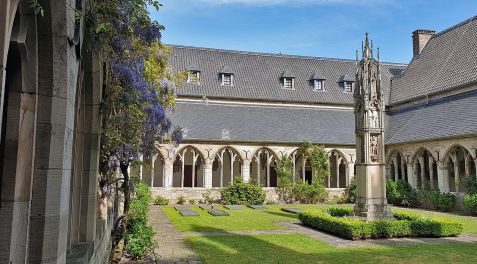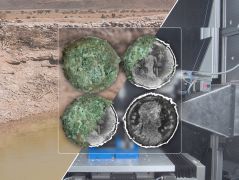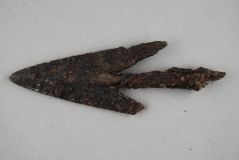MLZ is a cooperation between:
 > Technische Universität München
> Technische Universität München > Helmholtz-Zentrum Hereon
> Helmholtz-Zentrum Hereon
 > Forschungszentrum Jülich
> Forschungszentrum Jülich
MLZ is a member of:
 > LENS
> LENS > ERF-AISBL
> ERF-AISBL
MLZ on social media:

MLZ (eng)
Lichtenbergstr.1
85748 Garching
05.11.2020
Conservation: Nanolime used to prevent decay

Cloister of Xanten Cathedral: The columns are preserved with nano lime. © Wikipedia (Rolfcosar / CC BY-SA, https://commons.wikimedia.org/wiki/ File:Xantener_Dom_Kreuzgang.jpg)
Cultural artefacts such as murals or buildings made of calcareous material can often suffer significant damage from unavoidable exposure to various elements in their surrounding environment. Material referred to as nanolime is used to better protect and preserve this cultural heritage. Italian and Czech scientists performed experiments at the Heinz Maier-Leibnitz Zentrum (MLZ) to investigate how effectively nanolime protects porous material.
Murals in the ancient Italian city of Herculaneum, a bridge in the ancient theater of Megalopoli, the Xanten Cathedral on the Lower Rhine: what they all have in common is a long history and an interest in protecting them as cultural heritage. For this purpose, nanolime is used as an effective preservative. It consists of nano-sized particles of calcium hydroxide dissolved in alcohol. When this nanolime is applied to porous rock, calcium carbonate is produced which strengthens the material.
Scientists from the Czech Republic and Italy supported by Dr. Marie-Sousai Appavou, instrument scientist at Forschungszentrum Jülich, studied the effects of the strengthening treatment at MLZ. “Our aim was to quantify the structural changes of porous material after the application of the nanolime, in a completely non-invasive way,” explains Dr. Radek Ševčík from the Czech Academy of Sciences, one of the authors of the study. This enables the researchers to assess the effectiveness of the treatment. They carried out their investigations on limestone from Maastricht, which is seen as a standard exemplar in research on the conservation of cultural heritage.

On porous stone (left) nanolime is applied (middle). This forms calcium carbonate, which strengthens the material. The porosity decreases (right). © Reiner Müller / TUM
Neutrons are well suited for studying cultural heritage
For their analysis, the scientists used synchrotron X-ray tomography at the CERIC synchrotron radiation facility in Trieste, Elettra, and the neutron small angle scattering apparatus KWS-2 at MLZ. By combining these two methods of investigation for the first time, the researchers were able to visualize changes in the porosity of the material before and after treatment with nanolime on both the microscale and the nanoscale. Thus, they were able to examine the effects from a wide range of pore sizes. This is important because natural stone is often irregular in its composition.
“Thanks to the unmatched penetration depth of neutrons, we can non-invasively examine large samples”, Ševčík said to emphasize the importance of the neutron scattering method. “These aspects are of great interest especially for cultural heritage objects”. Overall, the researchers show in their paper a new methodological approach to verify the usefulness of conservation work without damaging valuable samples.
Nanolime strengthens material
“We were able to determine that the pore surface increases when treated with nano-lime. The porosity decreases,” summarizes Ševčík. The scientists postulate that the rock is more stable as a result.
Preservation with nanolime is used at a large number of cultural heritage sites. The range of applications is diverse and extends from the conservation of murals and frescos to the consolidation of natural stone for the preservation of historical monuments and statues.
Original publication
Ševčík, R., Viani, A., Mancini, L. et al. Investigation of nano-microstructural changes in Maastricht limestone after treatment with nanolime suspension. Appl. Phys. A 126, 367 (2020). https://doi.org/10.1007/s00339-020-03567-6
Related News
MLZ is a cooperation between:
 > Technische Universität München
> Technische Universität München > Helmholtz-Zentrum Hereon
> Helmholtz-Zentrum Hereon
 > Forschungszentrum Jülich
> Forschungszentrum Jülich
MLZ is a member of:
 > LENS
> LENS > ERF-AISBL
> ERF-AISBL
MLZ on social media:




